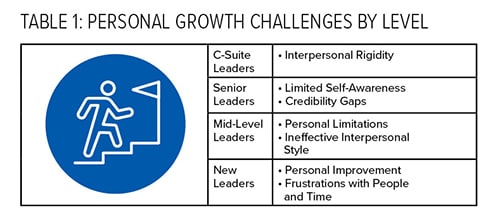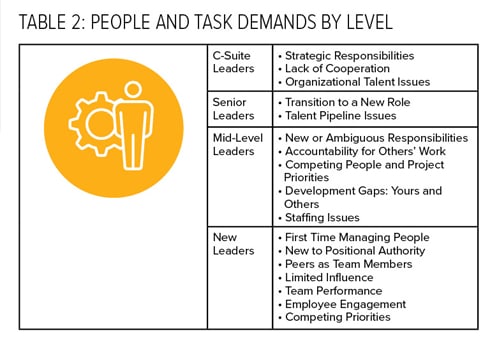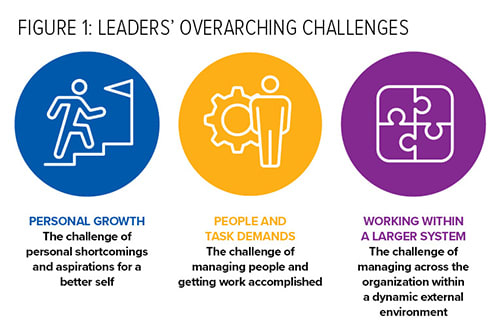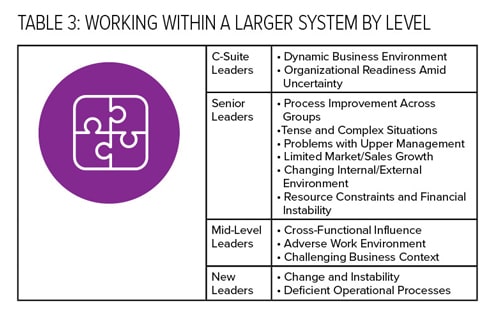The Chief of Leadership Development:
Preparing Today’s Leaders for Tomorrow’s Challenges
Leaders of organizations currently face unprecedented challenges and disruption. Although pandemics and other current upheavals are exceptional events, it is not expected that our post-pandemic future will be smooth sailing. Leaders at all levels will continue to face a future of unknown difficulties and challenges.
These unknowns will stretch leaders’ capabilities, test their abilities to focus on what is most important and strain their resolve to step up to the novel issues and concerns of the day. Organizations need adept executives at the top, who know how to develop capable leaders at all levels with the right skills and perspectives to steer their companies through the inevitable rough waters. Preparing today’s leaders for tomorrow’s challenges is a leadership investment imperative.
Among all the responsibilities held by corporate executives, there is one role that cannot be overlooked nor overemphasized. It is the responsibility to build depth in leadership bench strength and cultivate leadership capacity throughout the organization. The Chief of Leadership Development role is shared by all executives.
Yet a recent Gartner report found that only 19 percent of learning and development (L&D) heads believe their organization is effective at achieving a high rate of learning as a result of leadership development.1 Similarly, a McKinsey study found only 11 percent of more than 500 executives around the globe strongly agreed with the statement that their leadership development interventions achieve and sustain the desired results.2 A Harvard Business School Publishing Report found that only 33 percent of line managers said they have become more effective as managers after taking part in development programs.3 With numbers like these, it is easy to see why executives and CHROs are having trouble justifying their leadership development budgets. CHROs know that they have to show ROI for development or they will almost certainly face budget cuts.
In this article, we identify the reasons for the current state of affairs and present original research from over 34,000 leaders from more than 6,000 organizations using machine learning text analytics. The goal of this research is to improve the ROI of leadership development by creating a framework based on leaders’ identified needs at all levels. In short, executives and the CHRO will be able to refocus their leadership development strategy by better understanding and placing leaders’ challenges at the center of development.
The Reasons for Failure
The source of many leadership development failures can be attributed to three issues.
- Organizations rarely do the work to thoroughly understand the breadth and depth of the challenges leaders face. This is in part because most L&D leaders report a lack of data-analytics savvy to systematically answer a fundamental question: What are the leader pain points we are solving for with leadership development?4 If organizations do not know the answer, they will have a difficult time deciding what skills and perspectives need developing.
- There is a gap between the skills that programs build and the skills that organizations require. For example, organizations often fail to bridge interpersonal skills with the hard skills needed to navigate today’s flat and networked organizations. Business schools in particular tend to focus on cognitive skill development but are less adept at teaching skills for working more effectively in teams.5
- The third issue stems from identifying responsibility for leadership development. For many years, HR bore that responsibility. This dependency mindset on HR is slowly shifting. The employee, line leaders, and HR all play a role. Individuals must own their development processes. Leaders need to coach and develop other leaders. Organizations and senior leaders need to work with managers to identify the leadership requirements, allocate necessary resources for development, and model effective leadership. Finally, HR needs to facilitate the entire process. How is this model of shared accountability working out? Not too well. According to Training Industry, leaders believe talent and leadership development is an 8 or a 9 in importance on a 10-point scale. However, the energy and accountability they devote to it reflects an importance level of 2 or 3.6
The Missing Link
What’s the missing link? An evidence-based framework for understanding leaders’ challenges across organizational levels. Leadership development will only be effective if it aligns to the corporate strategy and addresses the underlying pain points or challenges that leaders face at every level.7 Technological advances in big data methods, such as machine learning, can yield richer and more nuanced insights of how challenges vary by level.
To create an evidence-based framework, we developed a research study8 using eight years of open-ended text data collected from over 34,000 multilevel leaders working across more than 6,000 organizations. The leaders responded to the question, “What are the three most critical leadership challenges you are currently facing?” Using a machine learning text algorithm called topic modeling, we found 37 distinct challenges that persist over time and across different industries and sectors. We offer organizations insight into the self-reported challenges that leaders face across multiple levels.
Leaders’ Challenges at Multiple Levels
We organized the 37 challenges into three overarching types that leaders face: (1) personal growth, (2) people and task demands, and (3) working within a larger system (see Figure 1). Leaders experience personal growth challenges as they struggle with their shortcomings and aspirations for a better self. People and task demands arise from managing people and getting work accomplished. Because leaders are working within a larger system, they are also challenged to influence horizontally and lead within a dynamic external environment.

Although leaders at all levels experience each type of challenge, their complexity and scale increase as leaders move up. For example, in terms of personal growth (see Table 1), new leaders are challenged by self-doubt that comes with a lack of experience and the patience needed to interact with direct reports. Leaders at higher levels reported more nuanced personal growth challenges such as the need to build credibility across the organization as well as a need to change the way they interact with others to be more interpersonally effective.

For people and task demands (see Table 2), lower-level leaders reported challenges that reflected less discretion in solving problems and more narrow spans of control. For example, they often reported challenges that involve leading and influencing others without formal authority. Their primary responsibility was usually for their team’s output and development. For leaders at higher levels, people and task demands became more complex such that leaders had to consider multiple strategies and structures for solving them. Their span of control also was much broader, involving alignment of work across teams and divisions as well as responsibility for talent systems.
With regard to working within a larger system (see Table 3), leader levels varied in terms of likely time spent working in the broader organizational system and the changing external environment. Leaders at higher levels reported challenges that often require them to operate in these contexts more frequently than lower level leaders.
Our findings are aligned with and build upon classic work by Elliott Jaques9 on stratified systems theory. His work suggested that leadership requirements vary by management level in terms of complexity and interaction with the external environment. More recent research shows that the progression from junior to mid to senior levels also requires greater levels of cognitive, interpersonal, business and strategic skills.10
Though organizations have long known that leadership challenges vary by organizational level, our use of a machine-learning algorithm to analyze tens of thousands of open-ended leader responses yields a richer, more nuanced understanding of how the challenges vary by level. The machine-learning approach also led us to uncover a new category of leadership challenges rarely discussed in leadership development but was widely expressed by leaders in their own words: the need for personal leadership growth. This means that any leadership development effort must be designed to address fundamental aspects of the leader’s inner existence in addition to skills and perspectives.
Set Up for Success
The leadership challenge framework provides CHROs a foundational tool for informing the design of leadership development strategy. It also helps leaders at each level work with the organization to select the best development methods for their needs as they manage their careers. Learning to lead more effectively involves getting feedback, setting challenging development goals and receiving support from others. HR supports development by: 1) aligning development with leaders’ needs, 2) scaling leadership development, 3) creating a strong partnership with managers and senior leaders and 4) executing a holistic development and growth strategy.
- Align development with leaders’ needs. This evidence-based framework can be used to increase the likelihood that leaders will develop balancing what they need individually with the requirements of business strategy. Whenever possible, organizations should also collect and score leadership challenge responses directly from their own leaders to determine the specific type and prevalence of each challenge. Organizations can poll leaders periodically to determine which leadership challenges are trending up or down.
- Scale leadership development. Large and mid-sized companies must deal with massive disruption and perpetual change, requiring aligned enterprisewide development. This research can provide a leadership challenge framework to inform career management efforts and help leaders know what is required to excel in their current role and prepare for the next level. Scaling leadership development efficiently and well enables organizations to shift their cultures, build common understandings and quickly execute their strategies to achieve goals.
- Create strong partnerships with managers and senior leaders. HR leaders face expanding responsibilities and limited budgets. The current talent war means organizations will continue to face a shortage of leaders equipped to address future demand. As a consequence, organizations will increasingly depend on HR to facilitate creation of leadership development strategies, ensure execution and monitor ROI. HR can best deliver through partnering with both line managers and senior executives. This means clarifying responsibility for leader development at the individual, manager, function and organization level.
- Execute a holistic growth and development strategy. Leaders at all levels may be challenged by feelings of inadequacy. Acknowledging and preparing leaders to overcome challenges can accelerate development of their skills and perspectives—and create a shared understanding of what’s required across the organization. The key is to craft long-term development plans that simultaneously address skill development and the transformation of leaders’ self-identity. Leadership development requires a holistic look at leadership—one that includes elements of the inner existence of leaders in addition to their outward behaviors.11
Key Takeaways
Executives and CHROs play a central role in equipping leaders at all levels with the right skills and perspectives for the disruptions and challenges of today and in the future. Advances in machine learning text analytics have resulted in the identification of leaders’ critical challenges utilizing large-scale data.
In this study, we analyzed comments from over 34,000 leaders across multiple organizational levels in more than 6,000 organizations. This led to the identification of three overarching challenges areas based on what leaders say they need:
- Personal growth: The challenge of personal shortcomings and aspirations for a better self.
- People and task demands: The challenge of managing people and getting work accomplished.
- Working within a larger system: The challenge of managing across the organization within a dynamic external environment.
In addition, this study differentiates specific and nuanced needs identified across four leader levels including C-suite, senior, middle and new leaders. Understanding an organization’s needs in the context of these data-driven findings can enrich the dialogue about how to best address both individual leader and organizational needs. The resulting multilevel framework based on this research may be useful to:
- Inform a company’s leadership development strategy toward increasing its ROI. Organizations can collect and score leadership data directly from their own leaders to determine the specific type and prevalence of each challenge.
- Create a clear and transparent roadmap for a companywide career management function where leaders at all levels understand the key steps for career progression. A company’s leadership pipeline could grow as more “hidden” or overlooked leaders self-select into the process.
- Align HR and business leaders around the organization’s central leader challenges. This may, in turn, increase the odds that leadership development is seen as a key driver of business strategy and not just another hat HR has to wear.
- Inform an organization’s general approach to leadership development design and delivery. Leader transformation at all levels involves facing three major types of complex challenges across four leader levels. Practitioners must design initiatives that address inner challenges and outward behaviors.
Leadership development can be improved by seeking a data-driven answer to the following fundamental question: What leader pain points are we addressing through our leadership development strategies? Asking and answering this key question will increase the probability that executives, CHROs and line managers focus their efforts on what matters most and align on the leadership development initiatives that will enable their organizations to thrive in a post-pandemic world. Preparing today’s leaders for tomorrow’s challenges is a primary investment and executive imperative.

| Stephen Young, Ph.D., is Manager of Leadership Analytics at the Center for Creative Leadership. He can be reached at youngs@ccl.org.
|

|
Jean Brittain Leslie is a Senior Fellow and Director of Strategic Initiatives at the Center for Creative Leadership. She may be contacted at lesliej@ccl.org.
|

|
Ramya Balakrishnan is a Data Scientist at the Center for Creative Leadership. She may be contacted at balakrishnanr@ccl.org.
|

| Brad Winn, Ph.D., is a Professor of Practice in the Covey Leadership Center and Executive MBA Director in the Huntsman School of Business at Utah State University. He serves as a Senior Editor for People + Strategy and is the Principal of Winn Consulting Services. He can be reached at brad.winn@usu.edu or through https://huntsman.usu.edu/directory/winn-bradley.
|
References
7 Collins, D. B., & Holton, E. F. (2004). The effectiveness of managerial leadership development programs: A meta‐analysis of studies from 1982 to 2001. Human Resource Development Quarterly, 15, 217–248.
8 Balakrishnan, R., Young, S., Leslie, J., McCauley, C., & Ruderman, M. (2021). Leadership Challenger Ladder (LCL) Technical Report. Greensboro, NC: Center for Creative Leadership.
9 Jaques, E. (1978). General theory of bureaucracy. Exeter, NH: Heinemann Books.
10 Mumford, T. V., Campion, M. A., & Morgeson, F. P. (2007). The leadership skills strataplex: Leadership skill requirements across organizational levels. The Leadership Quarterly, 18, 154-166.
11 Ruderman, M., Clerkin, C., & Connolly, C. (2014). Leadership development beyond competencies: Moving to a holistic approach [White paper]. Greensboro, NC: Center for Creative Leadership.
https://doi.org/10.35613/ccl.2014.1043












